No. 10: Veterans Day Celebration
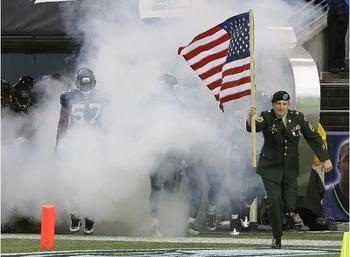
http://static.nfl.com/static/content/public/image/getty/2011/09000d5d82412c1f_gallery_600.jpg
Last November, the NFL announced a new annual program entitled the Salute to Service campaign, which has and will continue to take place every November near the time of Veterans Day.
From NFL.com:
The "Salute to Service" campaign is designed to unify and elevate the extensive military appreciation work of the NFL and its clubs. Throughout November, teams will designate home games as special military appreciation games. During these games, teams will display "Salute to Service" banners on their sidelines, in addition to hosting ceremonies to honor the service and sacrifice of our nation’s troops.
For years, the NFL has honored members of the military and their families through the USO and other programs. For example, recently, Bill Cowher, Leslie Frazier and Eric Mangini visited troops serving in the Persian Gulf. This type of "giving back" to the military has become a common occurrence.
But the implementation of the Salute to Service program extends the appreciation for our soldiers and soldiers' families much further। When an entire game, across 32 cities and stadiums, is dedicated to the troops who have served, the patriotism is off the charts.
No. 9: The NFL During World War II

http://upload.wikimedia.org/wikipedia/en/0/0c/Steagles_photo.jpg
Even if it's not a specific "moment," this episode in NFL history was exceptionally patriotic.
Major League Baseball's continued play during World War II—which stole so many athletes' prime years away from the game in service—has often been hailed as a great episode in American sports history. But there's a case to be made that, during those same years, the NFL's ability to survive, even thrive, was even more memorable.
Despite the financial state, as well as simply a lack of players, teams were forced to merge. Case in point, the Steelers joining forces with the Eagles (to create the Steagles) and, later on, the Steelers merging with the Cardinals (to create the Card-Pits). Somehow during those less-than-ideal circumstances, the league survived when it was still in a state of relative infancy.
That had to serve as an example of persistence and determination, and proof that Americans would not completely sacrifice their way of life or abandon their passions, even in the midst of a gripping world war।
No. 8: Super Bowl XV
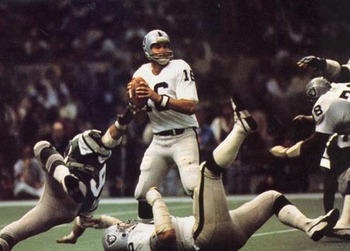
http://www.raiders.com/history/super-bowl-xv.html
Super Bowl XV, which took place in January 1981, was filled with wonderful subplots, including the Eagles' first championship game berth in 20 years, the resurrection of Jim Plunkett's career, and the fact that the Raiders were the first team to reach the Super Bowl as a wild card.
But, to many, all those angles took a back seat to the resolution of the Iranian hostage crisis, which ended just five days prior to the big game.
As a way to honor the Americans who survived 444 days of captivity, the Louisiana Superdome—the site of Super Bowl XV—was fitted with an enormous yellow bow to signify the end of the harrowing event।
No. 7: 10 Years After 9/11
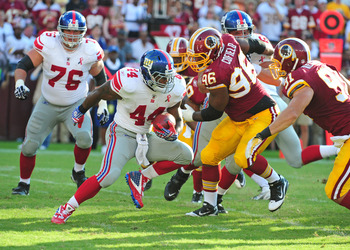
Scott Cunningham/Getty Images
Clearly, 9/11 has a prominent place on this list: Despite the horrific nature of the attacks our country befell, they inspired incredible pride within the country and especially within those who fought (and fight) to protect it.
And while the moments closer (in both time and pain) to the actual events of September 11, 2001, were more influential and dramatic, the tragedy's anniversaries hold powerful significance as well.
So, when the Jets hosted the Cowboys just a dozen or so miles from where the World Trade Center once stood, and when the Giants and Redskins—representing two of the cities attacked by al-Qaeda—squared off exactly 10 years after the tragic events of 9/11, Americans reflected on the sadness and angst the attacks created। It also showcased just how much healing the nation had experienced.
No. 6: Rocky Bleier Returns to the NFL

http://sportsillustrated.cnn.com/multimedia/photo_gallery/1101/nfl-pittsburgh-steelers-classic-photos/content.17.html
Roger Staubach may have been the Golden Boy and a national treasure of sorts—Navy Captain, quarterback for "America's Team"—but one of his contemporaries, and a man who was part of two Steelers teams to defeat Staubach's Cowboys, was also a source of great inspiration and patriotism for Americans.
After his rookie season in 1968, Rocky Bleier left the Pittsburgh Steelers upon being drafted to serve in the Vietnam War. While in Southeast Asia, Bleier was shot in the thigh and took shrapnel in his leg via an exploding grenade, per Cameron Martin and ESPN.
For his valor, Bleier was awarded the Bronze Star and Purple Heart, but also faced with the reality that a future in the NFL was no more.
Nevertheless, despite struggling just to walk, Bleier defied all odds and returned to the Steelers a year later। He earned a key offensive place on one of the NFL's all-time greatest dynasties, winning four Super Bowls along the way and becoming a symbol of both patriotic sacrifice and resilience.
No. 5: Patriots Triumph in Super Bowl XXXVI

Ronald Martinez/Getty Images
The fact that the team dons red, white and blue and named the "Patriots" is a huge part of this entry. After all, that's just tremendously wonderful irony (unless you were a Rams fan) given the circumstances that surrounded the entire 2001 season (more on that later).
But more to the point, that season the NFL was overshadowed by the events of 9/11, and more than ever, the entire country was in desperate need of the occasional distraction, even if only for a few hours each week. Sports has always provided that invaluable service.
The enormous underdog Patriots—not just on Super Bowl Sunday, but late in the Divisional Round against Oakland, on the road in Pittsburgh in the AFC Championship Game, all the while playing with a no-name sixth-round pick named Tom Brady—were the perfect such case.
So, when they capped off one of the most improbable championship seasons in NFL history, they had captured more than just a Super Bowl ring; in a way, they captured the hearts of millions of Americans। To many, even those who weren't Pats fans, that squad was a real source of inspiration and may have been more "America's Team" than the Dallas Cowboys ever were.
No. 4: Playing Games on "Kennedy Sunday"
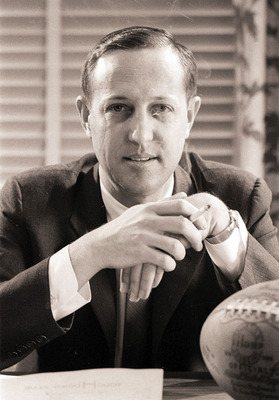
http://sportsillustrated.cnn.com/multimedia/photo_gallery/1202/athletes.who.smoke/content.8.html
He may have later admitted that it was the greatest regret during his 29 years as NFL commissioner, but Pete Rozelle's decision to play the NFL's full slate of games just a few days after President John F. Kennedy's assassination was a necessity.
Several of the entries on this list were important because they helped Americans maintain their way of life without letting tragedy consume them. It's one thing to be dealt a loss or tremendous sadness, and still another thing to feel helpless and paralyzed by it.
That (along with the blessing from Kennedy's press secretary Pierre Salinger) prompted Rozelle to go through with the seven NFL games scheduled for Sunday, November 24, 1963.
Right or wrong, Rozelle's decision gave thousands, if not millions, of Americans a brief respite from the sadness of the largely beloved President's tragic assassination and passing।
No. 3: Honoring Pat Tillman
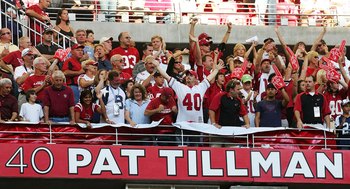
Robert Laberge/Getty Images
The loss of Pat Tillman was a terrible tragedy for both America and the NFL. But as tragic, depressing, confusing and painful as it was, the outpouring of emotion and love that followed was a fine example of this country's patriotism.
Even though his death was the result of a controversial war, his sacrifice and spirit were and will always be remembered.
Tillman gave up a successful, and lucrative, pro football career to defend his nation, so when his former team and the entire league honored him and retired his jersey during the September 19, 2004, game between the Cardinals and Patriots at Sun Devil Stadium (the site of so many of Tillman's wonderful exploits as a star at Arizona State), all fans paid memorable tribute to a true American hero।
No. 2: Post-9/11 Return to Football

http://theboysareback.wordpress.com/category/media-source-dallasft-worth/san-antonio-express-news/
After the postponement of the league's 2011 Week 2 schedule, play resumed 12 days after the September 11 attacks. And throughout all 15 sites that hosted games that week, there were tremendously high spirits in the air.
Fans and players cheered as American flags blanketed the stadiums and the field, and when the stadiums' loudspeakers blasted "America the Beautiful" and the "Star-Spangled Banner."
But the most patriotic element on display that day may well have been the red, white and blue banners on display in every end zone। They read "United We Stand."
No. 1: Whitney Houston and Super Bowl XXV
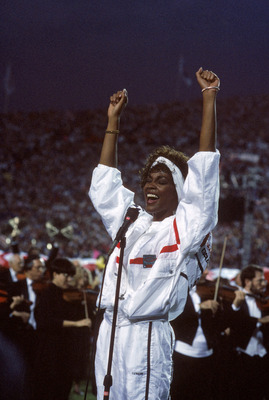
George Rose/Getty Images
The first Gulf War didn't have the same type of overarching, national tragedy feel to it that 9/11 did, but at the time, there were serious concerns about the safety of Americans both at home and those abroad serving in the military.
So, with Operation Desert Storm only 10 days old, American patriotism was already peaking—especially since, in some ways, the Super Bowl is always a supremely patriotic even. That very week, NFL commissioner Paul Tagliabue compared the Super Bowl to "the winter version of the Fourth of July celebration."
But all of that patriotism and pride reached a new level, one that perhaps no other American sports scene has ever experienced, right before the Bills and Giants kicked off Super Bowl XXV on January 27, 1991.
Just before F-16s flew over a stadium filled with more than 70,000 fans holding miniature American flags, Whitney Houston belted the "Star-Spangled Banner" with such zeal and passion that it brought players, coaches and fans to tears. It arguably remains the most famous performance of America's National Anthem of all time.
Given the newness of the war (America's first in a generation) and the uncertainty that awaited, Houston's performance of the song just resonated so closely with so many Americans that it will forever be linked to that event and, in a way, the Super Bowl itself.
No comments:
Post a Comment